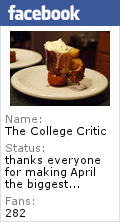I spent most of my evening at Ai Fiori looking out the window at Burger King.
Ai Fiori is an Italian restaurant on the second floor of the Setai Hotel off Fifth Avenue. Michael White, the chef, hails from Wisconsin and cooks with a Midwestern sensibility: he has a heavy hand with pork fat. New York Post critic Steve Cuozzo called White’s lobster with white wine sauce “the greatest dish in the world.” I did not order it.
Instead, I started with scallops and celery root, seafood and vegetable sliced symmetrically, both nestled in a bone split lengthwise and slathered with melted marrow. After eating half the serving—and finishing my cocktail, a rare treat now that I am legal and ‘ready to party’—I felt full. It would be a long and distended meal, pregnant with butter—my belly swollen, sore and satisfied.
If White’s food is sensual, it is not sexual. It seems divorced from desire. Despite a saturation of color and scent, the plates refuse any procreative impulse. I did not want to fuck my food, only luxuriate in its lovely caresses. (Black truffle, sandwiched between each piece of scallop and root, is exemplary of this phenomenon. Pungent, but not poignant. Funky, but not freaky. Fungal, but not fungible.)
A heap of trofie nero, black as my true love’s hair, comes coated in a dense crustacean ragu. Too sour for my sweet tooth, the ragu is topped with a crunchy layer of spiced bread crumbs. What this pasta needs is a spoonful of sea urchin, for sweetness, for brine, for an undercurrent of oceanic life. Without a mineral tang of sea and salt, the noodles are a little limp, the sauce terribly lifeless. Where is the erotic energy? Lost somewhere between seppia and scallop.
In one of my favorite paintings, “Night Windows,” a female figure bends over, back to the picture plane. Clad in a pink nightgown, the woman stands before the telltale window, unaware that the viewer—and perhaps a host of other peeping toms or voyeurs—peeks into her apartment. The room, illuminated with a diffuse and blinding cloud of white light, is a space of warmth and excitement in an otherwise shadowy city. Edward Hopper has added a curtain blowing out into the night as a kind of compositional counterpoint to the woman. Through the window, exterior and interior exchange fluids, auras, energies. But if the woman and her apartment are open for visual inspection, their stories are not. We are left to imagine a universe—a cosmos of ordinary experience—that remains unspoken. Perhaps, the woman is named Lily. She fixes a drink for her husband, a handsome man with blue eyes and an angular jaw who, rather than return home, sleeps with a jazz-fling-thing. This tiny tale is fair supposition, because Hopper’s paintings invariably gesture towards the melancholy resonances of urban reality. There are no happy endings in Hopper’s occluded histories.
My seat faces the street, and I can see a Burger King in the building opposite. Like Hopper’s “Night Windows,” the Burger King is an oasis of hyper-white illumination. Its neon sign glitters like costume jewelry, suspended above empty booths and beckoning prospective diners inside. Although I watch the Burger King for two hours, I only notice one person go in—I am too far away to discern his features, but he looks cold and hungry. I feel a kinship with him, for on this occasion February has seeped into my bones. I have not been warm or satisfied for two weeks.
Fulfillment comes in the form of duck breast, very rare, a soft wobbly chunk of foie gras, and sweet chestnut. I needed something sanguineous to soothe my spirit. The human body craves blood. I have been studying Greek mystery cults, and I sense a relationship between my feast and esoteric fertility rituals. I have been sacrificed, my corpse burnt, and my ashes spread over barren fields. April will come soon enough.
Dinner finishes with a dark chocolate tart. (Walnut gelato, grape gel, and caramelized sherry garnish the ganache.) I sip some dark coffee and say goodbye to Burger King. We had a great thing while it lasted.

